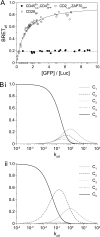The T cell receptor triggering apparatus is composed of monovalent or monomeric proteins
- PMID: 21757710
- PMCID: PMC3173209
- DOI: 10.1074/jbc.M111.219212
The T cell receptor triggering apparatus is composed of monovalent or monomeric proteins
Abstract
Understanding the component stoichiometry of the T cell antigen receptor (TCR) triggering apparatus is essential for building realistic models of signal initiation. Recent studies suggesting that the TCR and other signaling-associated proteins are preclustered on resting T cells relied on measurements of the behavior of membrane proteins at interfaces with functionalized glass surfaces. Using fluorescence recovery after photobleaching, we show that, compared with the apical surface, the mobility of TCRs is significantly reduced at Jurkat T cell/glass interfaces, in a signaling-sensitive manner. Using two biophysical approaches that mitigate these effects, bioluminescence resonance energy transfer and two-color coincidence detection microscopy, we show that, within the uncertainty of the methods, the membrane components of the TCR triggering apparatus, i.e. the TCR complex, MHC molecules, CD4/Lck and CD45, are exclusively monovalent or monomeric in human T cell lines, implying that TCR triggering depends only on the kinetics of TCR/pMHC interactions. These analyses also showed that constraining proteins to two dimensions at the cell surface greatly enhances random interactions versus those between the membrane and the cytoplasm. Simulations of TCR-pMHC complex formation based on these findings suggest how unclustered TCR triggering-associated proteins might nevertheless be capable of generating complex signaling outputs via the differential recruitment of cytosolic effectors to the cell membrane.
Figures






Similar articles
-
Initiation of T cell signaling by CD45 segregation at 'close contacts'.Nat Immunol. 2016 May;17(5):574-582. doi: 10.1038/ni.3392. Epub 2016 Mar 21. Nat Immunol. 2016. PMID: 26998761 Free PMC article.
-
How does T cell receptor clustering impact on signal transduction?J Cell Sci. 2019 Feb 11;132(4):jcs226423. doi: 10.1242/jcs.226423. J Cell Sci. 2019. PMID: 30745330 Review.
-
T-cell growth, cell surface organization, and the galectin-glycoprotein lattice.Immunol Rev. 2009 Jul;230(1):232-46. doi: 10.1111/j.1600-065X.2009.00796.x. Immunol Rev. 2009. PMID: 19594640 Free PMC article. Review.
-
Differential association of CD45 isoforms with CD4 and CD8 regulates the actions of specific pools of p56lck tyrosine kinase in T cell antigen receptor signal transduction.J Biol Chem. 2002 Jan 18;277(3):1912-8. doi: 10.1074/jbc.M108386200. Epub 2001 Nov 2. J Biol Chem. 2002. PMID: 11694532
-
Tyrosine 192 within the SH2 domain of the Src-protein tyrosine kinase p56Lck regulates T-cell activation independently of Lck/CD45 interactions.Cell Commun Signal. 2020 Nov 23;18(1):183. doi: 10.1186/s12964-020-00673-z. Cell Commun Signal. 2020. PMID: 33225946 Free PMC article.
Cited by
-
Polyvinyl Chloride Nanoparticles Affect Cell Membrane Integrity by Disturbing the Properties of the Multicomponent Lipid Bilayer in Arabidopsis thaliana.Molecules. 2022 Sep 11;27(18):5906. doi: 10.3390/molecules27185906. Molecules. 2022. PMID: 36144641 Free PMC article.
-
Lck, Membrane Microdomains, and TCR Triggering Machinery: Defining the New Rules of Engagement.Front Immunol. 2012 Jun 12;3:155. doi: 10.3389/fimmu.2012.00155. eCollection 2012. Front Immunol. 2012. PMID: 22701458 Free PMC article.
-
Pre-clustering of the B cell antigen receptor demonstrated by mathematically extended electron microscopy.Front Immunol. 2013 Dec 6;4:427. doi: 10.3389/fimmu.2013.00427. eCollection 2013. Front Immunol. 2013. PMID: 24367367 Free PMC article.
-
Approach to map nanotopography of cell surface receptors.Commun Biol. 2022 Mar 9;5(1):218. doi: 10.1038/s42003-022-03152-y. Commun Biol. 2022. PMID: 35264712 Free PMC article.
-
Recent advances in understanding TCR signaling: a synaptic perspective.Fac Rev. 2023 Oct 16;12:25. doi: 10.12703/r/12-25. eCollection 2023. Fac Rev. 2023. PMID: 37900153 Free PMC article. Review.
References
-
- Salzmann M., Bachmann M. F. (1998) Mol. Immunol. 35, 271–277 - PubMed
Publication types
MeSH terms
Substances
Grants and funding
LinkOut - more resources
Full Text Sources
Research Materials
Miscellaneous

